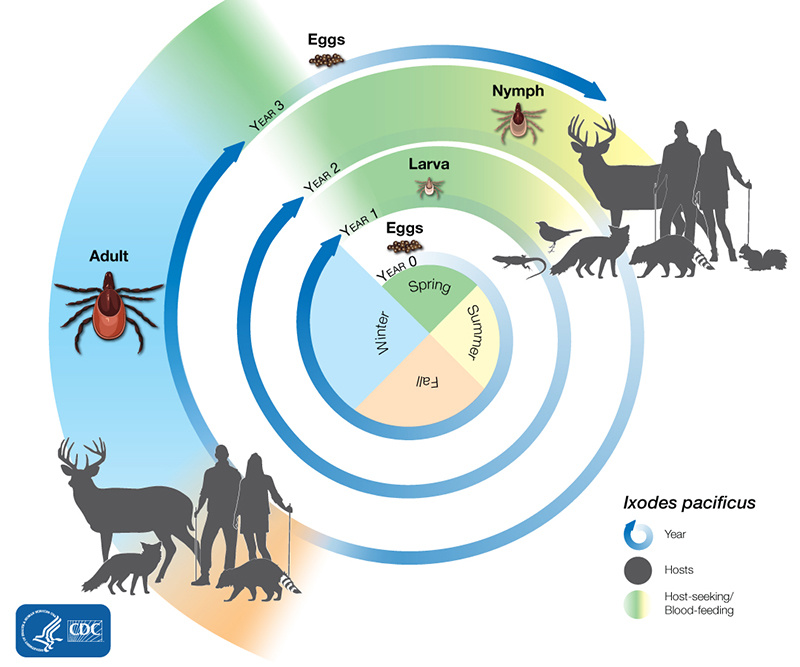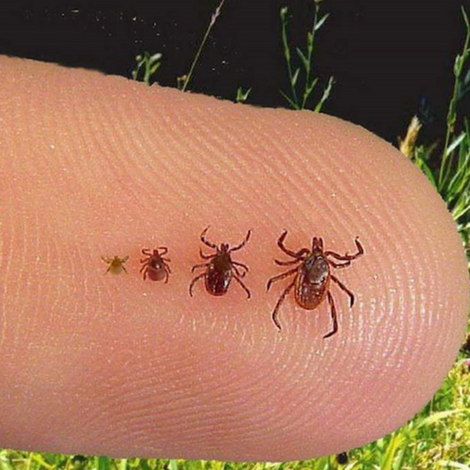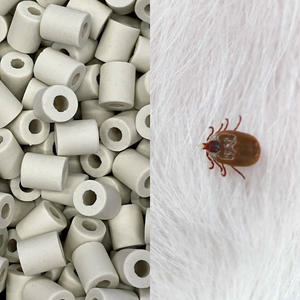EM Ceramic against Ticks BLOG
What are ticks?
Ticks belong to the arachnids and are closely related to mites. The female ticks suck blood, drop to the ground and lay their eggs there. Larvae hatch from them. These larvae look for a host to suck blood. These hosts are usually forest mice, birds and hedgehogs. The larva drops to the ground and after a resting phase develops into a nymph.
The nymphs look for a suitable host, usually medium-sized mammals. The nymph also drops to the ground and develops into an adult tick after a resting period of 3 months to 2 years. This resting period depends on the temperature.
Adult ticks wait in forests and bushes for a suitable host. These hosts are larger animals, such as your dog or cat. However, you can also get a tick on your body yourself. This is sometimes the case after a walk in the forest.

source: cdc.gov
What does a tick look like?
Ticks look like small spider-like animals that slowly walk across your pet's skin. They feed by sucking the blood of the host. A tick that has not yet fed is very small and hardly noticeable, but a tick after a blood meal is many times larger. A tick is usually noticed when you stroke your dog or cat. It feels like a lump.

Can dogs and cats catch ticks?
Yes, dogs and cats can be bitten by ticks. Ticks are mainly found in vegetation-rich areas such as forests, but also in many gardens. Ticks sit on plants and shrubs that are close to the ground. When a human or animal walks past the tick, it falls on the victim. Here it looks for a piece of skin to bite into. Therefore, it is important that you always check your dog for ticks after a visit to the forest.
Check your dog or cat for ticks
It is important to check your pet for ticks after every walk (including in the garden). Check especially behind the ears, in the armpits and in the groin!
Can dogs and cats get sick from a tick bite?
Your pet can develop an inflammation or even an abscess at the bite site. Toxins can also cause various problems. In addition, pets can develop symptoms if they are bitten by a large number of ticks. All ticks suck a tiny bit of blood from your pet. If many ticks do this, the pet may lose so much blood that it becomes anaemic. Pets can even die from anaemia caused by tick bites.
The biggest danger is the diseases that ticks can transmit. This happens 24-48 hours after they have attached themselves to your pet.
What is EM Ceramics (EM-X beads)?
Dr. Teruo Higa
Japanese researcher Dr Teruo Higa - the supposed inventor of the bead - has a wealth of research to his name. We visited the website of EMRO, a company that produces EM on a large scale, to learn more about "his" EM beads. The website is https://www.emrojapan.com. It soon turned out that the researcher is indeed associated with EM, but has nothing to do with the beads or the anti-flea or tick collars.
According to the website, Dr. Higa got the idea for EM when he was researching mandarins as part of his doctoral thesis in agriculture. As a result of daily contact with artificial fertiliser, he developed physical ailments. At that time, fertilisers and pesticides were still widely used in agriculture, as the production of organic fertiliser is very labour-intensive.
This mandarin research gave him the idea that it would be nice if there was a safer and natural alternative. From that moment on, he was determined to find out if safe and harmless bacteria could help. Every day he collected different strains of bacteria in a bucket so that he could properly dispose of them at the end of the research day. Until that day when he did something different than usual, and instead of throwing away the bucket of bacteria, he spread it in a meadow. A week later, the grass grew much more luxuriantly in that very spot than anywhere else.
The concept of a new, safe kind of fertiliser was born: EM. EM® is a brand name that refers to a group of microbial products developed by Dr. Higa. EM stands for "Effective Microorganisms". These are living organisms that are so small that they cannot be seen with the naked eye. Bacteria, yeasts and moulds are microorganisms. So any mixture of these can fall under the term "EM". But the mixture that this article is about and refers to when talking about EM beads consists of:
- Lactic acid bacteria
- Yeast
- Phototrophic bacteria
The EM developed by the Japanese researcher is a mixture of the above organisms in a liquid. But how does this alternative fertilisation contribute to anti-flea beads for dogs and cats? Perhaps the effect of EM will give a clearer picture?
How EM-X or EM works
As mentioned earlier, EM consists of a mixture of lactic acid bacteria, yeast and phototrophic bacteria. The principle of EM is based on increasing the diversity of naturally occurring microorganisms in the soil, thereby enriching the soil and increasing yield. The manufacturer claims that EM makes the soil healthier and more balanced, making plants healthier and more resistant to damage from stress factors such as diseases or harmful insects. Since the composition of EM is not yet fully known, nor is its interaction with the substances and organisms already present in various soils, this type of research has been carried out worldwide for years. Since it is supposed to be an environmentally friendly solution, it is receiving a lot of attention. Research results with EM are mixed, to say the least.
But what about animals? Dr Higa's website states that EM could also be used in animal husbandry. The main benefit is that the various microorganisms enrich the animal's environment. When EM is sprayed as a liquid in the stable, a better balance between good and bad bacteria is created. This would improve the overall hygiene in the house, which in turn would have a positive effect on the health of the animals. Animals would also benefit from ingestion. Adding EM to drinking water and feed would enrich the good bacteria in the gut, making animals more resistant to disease. For these reasons, the use of antibiotics (to fight bacterial infections) and disinfectants (against bacteria) would be less necessary.
There is also a sentence about the use of a spray with EM as a natural shampoo and possibly an indirect promotion of the intestinal flora. This claim is not supported by research.
And what about fleas and ticks? They are not mentioned on the website. None of the experimental animals involved in the EM studies wore a necklace or collar, or wore beads or other ceramic objects. The ceramic beads themselves were not designed by Dr Higa, so Dr Higa is not the inventor of the alleged natural ceramic bead.
EM-X Ceramic Beads against Ticks
For some years now, EM-X ceramic beads have been used to protect dogs and cats. Ceramics are centuries old and the beads are not new either. Ceramics are very porous and therefore have a filtering effect. Similar EM-X beads are used in aquariums and to purify drinking water. The good bacteria live in the porous surfaces and "fight" the bad bacteria.
Our opinion on EM-X beads in the fight against ticks
123paracord has been selling ceramic beads for a few years now. Especially in spring (February to June) we sell a lot of beads. Our customers then use these beads in collars for dogs and cats. Although it is not scientifically proven that the beads protect against ticks, we get many positive reactions from our customers and the rest of the market. Customers have noticed that their four-legged friends are less or not at all infested with ticks.
What can you make with EM-X beads?
These beads are commonly used to make tick collars that provide protection from ticks. Two well-known types of knots are the snake knot and the cobra knot that are made.
At 123paracord you buy your EM Ceramic per bead, in a bag of 35 pieces or in a discount pack of 500 grams.
Watch one of the most watched tutorials on YouTube about making a ceramic necklace here:


